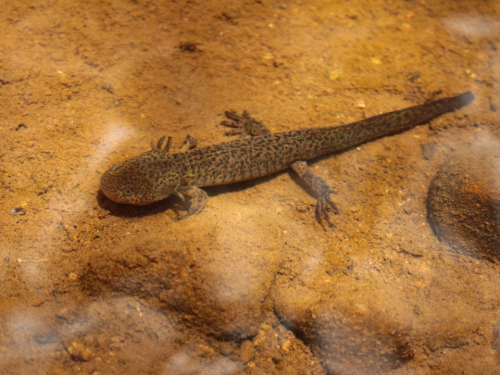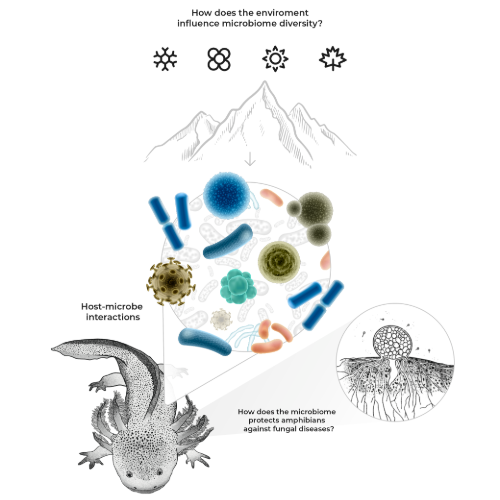To be still is not an option: Understanding the influence of environmental variation over amphibian skin microbiomes
Posted on February 5, 2024 by Emanuel Martínez-Ugalde
Emanuel Martínez-Ugalde takes us behind the scenes of their latest publication 'Gene functions of the Ambystoma altamirani skin microbiome vary across space and time but potential antifungal genes are widespread and prevalent' published in Microbial Genomics.
Hello, my name is Emanuel Martínez. Currently, I'm a postdoctoral fellow at Universidad Nacional Autónoma de México (UNAM), Mexico. As a microbial ecologist I’m interested in understanding the eco-evolutionary mechanisms controlling host-microbiome interactions. This work was part of my dissertation project under the direction of Dr Eria Rebollar Caudillo at the amphibian microbial ecology lab at Centro de Ciencias Genómicas (UNAM).
As of now, we know that amphibian species around the world have been threatened by chytridiomycosis and emerging infectious disease caused by the fungal pathogens Batrachochytrium dendrobatidis (Bd) and B. salamandrivorans (Bsal). It has been suggested that host susceptibility against chytridiomycosis is a multifactorial phenotype controlled by host genetics, environment, and skin microbiome diversity. Specifically, skin microbiomes mediate host protection against these pathogens throughout the production of various compounds with antifungal activity.
In the Rebollar lab we are interested in understanding the factors that influence the diversity and function of amphibian skin microbes. During the last five years, we have been studying the skin microbial communities of axolotls, which are endangered amphibian species endemic to Mexico.

As part of my PhD project, we went to the field and collected 279 skin swab samples from metamorphic and not-metamorphic mountain stream axolotls (Ambystoma altamirani) over a year. First, we described that seasonal and geographical variation of various biotic and abiotic factors are influencing bacterial diversity over the skin of this species1.
In this work, published in Microbial Genomics, we used 40 skin microbiome samples to recover 92,000 microbial genes and 50 metagenome assembled genomes (MAGs) to evaluate whether seasonality, site elevation and Bd infection status were influencing the functional profiles of the A. altamirani skin microbiome. We found that microbial functions vary across time and space, however the infection status with Bd did not influence the functional diversity of the mountain stream axolotl microbiome.

Our work revealed that various genes linked to bacterial communication and competition as well as antifungal functions are prevalent in the A. altamirani skin microbiome. Notably our analysis showed that the abundance profiles of these genes vary between infected and not infected samples during specific seasons. We suggest that the presence of these genes could explain to some extent the tolerance status of A. altamirani against chytridiomycosis. In addition, we found that genes linked to biofilm formation and secondary metabolite biosynthesis (both linked to antifungal functions) were present in all skin microbiomes across time and space.
We hope that our results will be of interest to other research groups working with amphibian skin microbiomes and other animal-associated microbes. Especially to those groups interested in evaluating microbiome contribution to host survival against pathogens. In addition, we are eager to continue the characterization of genes linked to these anti-Bd functions in bacterial isolated form A. altamirani skin to validate the observations made in this work.
References
1 Martínez-Ugalde, E., Ávila-Akerberg, V., González Martínez, T.M. et al. The skin microbiota of the axolotl Ambystoma altamirani is highly influenced by metamorphosis and seasonality but not by pathogen infection. anim microbiome 4, 63 (2022). https://doi.org/10.1186/s42523-022-00215-7
Image Credits
Thumbnail: Laura Fabiola Espinosa Juárez
Banner Image: Víctor Daniel Avila Akerberg

